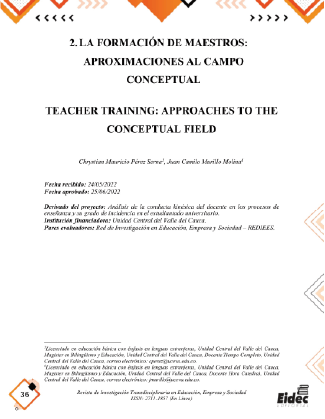II. TEACHER TRAINING: APPROACHES TO THE CONCEPTUAL FIEL
##plugins.themes.bootstrap3.article.main##
Abstract
This article presents the postulates of the authors who in turn use theoretical bases
concerning multimodality and the different forms of communication, to carry out a study in
which it can be observed how the use of these factors can be perceived by the students of the
Unidad Central del Valle. Among the aims of the study is to be able to relate whether students
can consciously or unconsciously perceive the use of teachers in the classroom by factors
such as body language, facial language, hand movement, eye movement, among others. Also,
to be able to determine whether such perception can positively or negatively affect the active
participation of students in academic activities. The foregoing was carried out using
qualitative instruments and using a methodology based on phenomenology. The research
findings illustrate the high degree to which students can receive the messages sent by the
teacher in the different forms of communication. The present study makes contributions to
the field of teacher training to the point that it provides important bases in the knowledge of
multimodality and communicative behaviors in the classroom.
Download Statistics
##plugins.themes.bootstrap3.article.details##
Multimodality, Student perception, Kinetic performance
Barmaki, R., & Hughes, E. C. (2015). A case study to track teacher gestures and
performance in a virtual learning environment .
Byram, M. (1997). Teaching and assessing intercultural communicative competence.
USA: Multilingual Matters.
Cardenas, C., & Duarte, C. A. (2015). Proxémica, Kinésica y Antropología. Apuntes
sobre simulación etnográfica, cuerpo y espacio en el marco del conflicto armado colombiano.
Cali .
Davis, F. (2010). La comunicación no verbal. Madrid: Alianza Editorial.
García, F. J. (2000). Comunicación no verbal, periodismo y medios audiovisuales.
Madrid: Universitas.
Hernández, H. M., & Rodríguez, E. I. (2009). Investigar en comunicación no verbal
un modelo para el análisis del comportamiento kinésico de líderes políticos y para la
determinación de su significación estratégica. Salamanca: enseñanza & teaching .
Martínez, B. A., & Camacho, B. A. (2014). La kinésica como medio publicitario .
Soacha: Corporación Universitaria Minuto de Dios.
Mehrabian, A., & Wiener, M. (1967). Decoding of inconsistent communications.
journal of personality and social psychology.
Moral, M. R. (1995). La expresión corporal en la relación maestro-alumno del nivel
superior. Mexico D.F.
Nierenberg, L. G., & Calero, H. H. (1976). EL LENGUAJE DE LOS GESTOS
COMO CAPTAR LO QUE NO SE DICE EN UNA NEGOCIACIÓN. EDITORIAL
HISPANO EUROPEA.
Rincón, A. J. (2010). La importancia de la comunicación no verbal en la enseñanza .
Revista de Investigación Transdisciplinaria en Educación, Empresa y Sociedad
ISSN: 2711-1857 (En Línea)
Tai, Y. (2014). The application of body language in English teaching. China:
Academy Publisher.
Tapia, V. A. (2020). Competencias comunicativas comportamentales: Propuesta de
una matriz de observación para estudiantes de pedagogía en contexto de diversidad cultural.
Temuco - Chile.
Torres, R. J. (2020). El discurso persuasivo como estrategia para combatir la
desconfianza política. Campaña de Rodolfo Hernández a la alcaldía de Bucaramanga
(Colombia 2015). Sevilla: Discurso & Sociedad.
Vilà, R. (2014). Juventud y comunicación intercultural. Currículo sem Fronteiras.
Zabetipour, M., Pishghadam, R., & Ghonsooly, B. (2015). The Impacts of
Open/Closed Body Positions and Postures on Learners’ Moods. Mediterranean Journal of
Social Sciences.
Hannan EL. Randomized clinical trials and observational studies: guidelines for
assessing respective strengths and limitations. JACC Cardiovasc Interv. 2008;1(3):211-7





